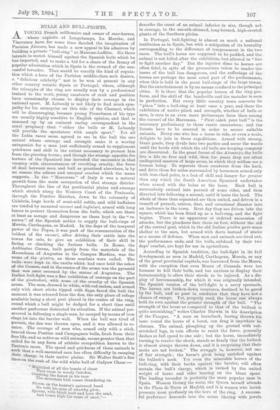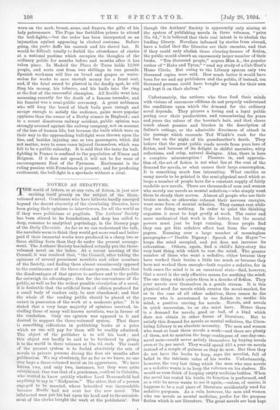BULLS AND BULL-FIGHTS.
AYOUNG French millionaire and owner of race-horses, whose exploits at Longchamps, La Marche, and Vincennes have for some time dazzled the imagination of Parisian flaneurc, has made a new appeal to his admirers by building a private " bull-ring " at Maisons-Laffitte. He there intends to match himself against the Spanish bulls which he has imported, and to make a bid for a share of the frenzy of popular admiration which in Spain is the reward of the sue- easeful toreador. That would be exactly the kind of reputa- tion which a hero of the Parisian middle-class mob desires, a "delicious celebrity" not to be won at present in any other country outside Spain or Portugal, whore, although the triumphs of the ring are usually won by a professional trained to the work, young amateurs of rank and position
have occasionally chosen to display their courage in the national sport. M. Lebaudy is not likely to find much sym- pathy for his enterprise on this side of the Channel, which will be discouraging, because young Frenchmen of his type are usually highly sensitive to English opinion, and that is summed up by an eminent racing correspondent in the cruel prophecy that " either the bulls or M. Lebaudy will provide the spectators with ample sport." Yet all the Latin races seem agreed to see in the bull the one animal whose courage and strength make it a worthy antagonist for a man just sufficiently armed to supplement quickness and skill to the extent necessary to protect him from the piercing horns ; and though the strange appetite for torture of the Spaniard has invested the encounter in that country with circumstances of revolting cruelty, the form of duel between man and bull as practised elsewhere, is by no means the odious and unequal combat which the name suggests. In the "Maremma" of Italy it was a natural growth from the main occupation of that strange district- Throughout the line of fiat pestilential plains and swamps which stretch along the Western Coast of the Peninsula, through the Pontine Marshes, down to the extremity of Calabria, huge herds of semi-wild cattle, and wild buffaloes are tended by mounted vaccari and buffaZari, armed with long lances to protect themselves from the bulls, which are there at least as savage and dangerous as those kept in the "re- serves " of the Spanish nobles to supply the bull-rings of Murcia, Carthagena, or Madrid. In the days of the temporal power of the Popes, it was part of the remuneration of the boldest of the vaccari, after driving their cattle into the towns for sale, to give an exhibition of their skill in facing or checking the furious bulls. In Rome, the Anfiteatro Correa, built partly from the materials of the Mausoleum of Augustus in the Campus Martins, was the scene of the giostra, as these combats were called. The bulls were kept in the vaults which had once held the ashes of the Caesars, and in the centre of the arena was the pyramid that was once crowned by the statue of Augustus. The Italian bull-fight was a fine exhibition of courage on the part of the giostratori, with none of the cruelty of the Spanish arena. The men, dressed in white, with red sashes, and armed only with short sticks tipped with flags, faced the bull the moment it was released from the den, the only place of refuge available being a stout post placed in the centre of the ring, round which a bull might be dodged for a short time until another performer distracted its attention. If the animal per- severed in following a single man, he escaped by means of iron rings let into the barrier wall. When the bull was tired of pursuit, the den was thrown open, and it was allowed to re- enter. The courage of men who, armed only with a stick, braved these Pontine and Campagnan bulls, fresh from their free life, and as active as wild animals, seems greater than that called for in any form of athletic competition known to the Teutonic races. The speed and quickness of these animals is such that a well-mounted man has often difficulty in escaping their charge in their native plains. Sir Walter Scott's fine lines on the rush of the wild white bull of Cadyow Chase :-
"Mightiest of all the beasts of chase
That roam in woody Caledon, Crashing the forest in his race The mountain bull comes thundering on.
Fierce, on the hunter's quivered band Re rolls his eyes of swarthy glow, Spurns, with black hoof and horn the sand, And tosses high his mane of snow,"— describe the onset of an animal inferior in size, though not in courage, to the smooth-skinned, long-horned, high-crested giants of the Southern plains.
In Portugal, bullfighting is almost as much a national institution as in Spain, but with a mitigation of its brutality
corresponding to the difference of temperament in the two
The bull's horns are supposed to be padded, and the animal is not killed after the exhibition, but allowed to "live to fight another day." But the injuries done to horses are often fatal, in spite of the precautions taken to render the horns of the bull less dangerous, and the sufferings of the are perhaps the most cruel part of the performance,. when this is held in the great bull-rings of the large towns.
But the entertainment is by no means confined to the principal cities. It is there that the popular heroes of the ring per- form, and the skill of the banderillo and the matador is seen in perfection. But every little country town converts its " plaza " into a bull-ring at least once a year, and there the exhibition of native pluck and strength, whether of bulls or men, is seen in an even more picturesque form than among the vaccari of the Maremma. " First catch your bull" is the necessary preliminary to these rustic encounters; and the forests have to be scoured in order to secure suitable animals. Every one who has a horse to ride, or even'a mule, delights to join in these expeditions. Armed with strong, blunt goads, they divide into two parties and scour the woods until the herds with which the old bulls are keeping company are discovered. In the great forest of the Alemtejo, the bulls live a life so free and wild, that for years they are often undisputed masters of large areas, in which they seldom see a human being. To separate these creatures from the herd, and drive them for miles surrounded by horsemen armed only with iron-shod poles, is a feat of skill and danger far greater than any which the South American Spaniard undertakes when armed with the bolas or the lasso. Each bull is successively enticed into pursuit of some rider, and then diverted into following a second, until it loses the herd. The whole of those thus separated are then united, and driven in a. tumult of pursuit, retreat, dust, and occasional disaster into an indosure in the town. Next day they are driven into the square, which has been fitted up as a bull-ring, and the fight begins. There is no apparatus or ordered succession of attacks, but the picadores face them on foot, without the aid of the central goal, which in the old Italian giostra gave some shelter to the men, but armed with darts instead of sticks as a means of defence. When men and animals are tired out, the performance ends, and the bulls, subdued by their two- days' combat, are kept for use in agriculture.
According to Spanish tradition, the bull-fight in its full development, as seen in Madrid, Carthagena, Murcia, or any of the great provincial capitals, was borrowed from the Moors, with the exception that even Moors of Granada were too humane to kill their bulls, and too anxious to display their horsemanship to allow their steeds to be injured. As a dis- play of horsemanship, for which it was originally intended, the Spanish version of the bull-fight is a sorry spectacle. The horses are broken-down creatures, destined to be gored by the bull, and so poor in condition that they have not a chance of escape. Yet, properly used, the horse can always hold its own against the greater strength of the bull. " The strength of the horse as compared to that of the bullock is quite astonishing," writes Charles Darwin in his description of the Pampas. "A man on horseback, having thrown his lasso round the horns of a boast, can drag it anywhere he chooses. The animal, ploughing up the ground with out- stretched legs, in vain efforts to resist the force, generally dashes at full speed to one side ; but the horse, immediately turning to receive the shock, stands so firmly that the bullock is almost always thrown down, and it is surprising that their necks are not broken." The struggle is, however, not one
of fair strength ; the horse's girth being matched against the bullock's neck. Yet even the miserable horses of the bull-ring, with their backs against the barrier, will often sustain the bull's charge, which is turned by the united weight of horse and rider bearing on the blunt spear. The leading toreador is probably the most popular man in Spain. Women throng the seats, the Queen herself attends in the Plaza de Toros at Madrid, and it is women who lavish presents most profusely on the hero of the ring. A success- ful performer descends into the arena blazing with jewels worn on the neck, breast, arms, and fingers, the gifts of his lady patronesses. The Pope has forbidden priests to attend the bull-fights,—but the order has been interpreted as an injunction against appearing in clerical costume. Before going, the padre doffs his cassock and his shovel hat. It would be difficult totally to forbid the attendance of clerics at a national pastime which occupies the thoughts of the ordinary public for months before and months after it has taken place. In Madrid the Plaza de Toros holds 12,000 people, and seats cost from two shillings to two pounds. Spanish workman will live on bread and grapes or water. melon for weeks to save enough money for a front seat, and, if the fatal sword be planted in the deadly spot, he will fling his money, his tobacco, and his knife into the ring at the feet of the successful champion. All Seville went into mourning recently for the death of a famous toreador, and his funeral was a semi-public ceremony. A great nobleman who will keep the breed of black bulls pure enough and savage enough to satisfy the audience, gains more popular applause than the owner of a Derby winner in England ; and in a recent disastrous railway accident, public opinion was strongly aroused against the railway company, not on account of the loss of human life, but because the bulls which were on their way to the approaching bull-fight were thrown upon the line, and besides injuring one or two passengers, which did not matter, were in some cases injured themselves, which was felt to be a public calamity. It is said that the taste for bull- lighting in France is confined to the population of Nimes and Brignon. If it does not spread, it will not be for want of encouragement East of the Pyrenees. Excitement is the ruling passion with Frenchmen at present; and for producing excitement, the bull-fight is a spectacle without a rival.



































 Previous page
Previous page